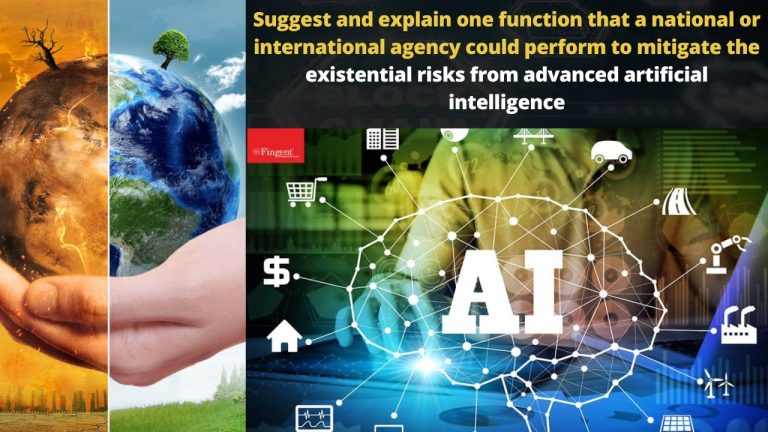"Advertisement"
Suggest and explain one function that a national or international agency could perform to mitigate the existential risks from advanced artificial intelligence
Introduction
Improved healthcare diagnoses and more industry automation are just a few of the advantages and prospects that the rapid development of artificial intelligence (AI) has brought us.
However, AI also carries existential concerns that necessitate immediate attention and international cooperation.
National and international agencies must cooperate in order to implement measures targeted at reducing the dangers that could be posed by highly developed artificial intelligence.
The Nature of Existential Risks from Advanced AI
Advanced AI poses existential hazards, which are dangers that could imperil the survival of humanity.
These dangers emerge from the potential for highly intelligent AI systems to outperform humans, make autonomous judgments that are beyond human control, and possibly produce disastrous results.
A complex strategy that incorporates legal frameworks, moral principles, research projects, and international cooperation is necessary to effectively tackle these hazards.
The Role of a National/International Agency: AI Risk Assessment and Regulation
Establishing a thorough framework for AI risk assessment and regulation is a crucial task that a national or international organization may carry out to reduce existential dangers from advanced AI.
The following essential elements would be included in this function:
1. Risk Profiling and Categorization:
The agency would be in charge of evaluating any hazards connected to various AI systems and applications.
The agency can effectively prioritize its efforts and resources by classifying AI technologies based on their level of autonomy, potential impact, and ethical considerations.
2. Ethical Guidelines and Principles:
The creation of a set of ethical standards and principles that can be used in AI research and development is crucial.
These rules would guarantee that AI systems uphold human values and don’t jeopardize people’s safety and well-being.
3. Licensing and Certification:
It might be possible to guarantee that only people who follow safety procedures and ethical standards can work on sophisticated AI projects by introducing a licensing or certification scheme for AI developers and researchers.
As a result, the AI community would be held to a certain standard of accountability.
4. Mandatory Impact Assessments:
Impact assessments should be required before implementing powerful AI systems in crucial industries like healthcare, banking, or transportation.
The organization could impose rules requiring AI developers to provide evidence of the security, dependability, and potential repercussions of their systems.
5. International Collaboration:
The development of AI is a worldwide endeavor, hence international cooperation is essential.
To develop a comprehensive international plan for AI risk mitigation, the agency may support information sharing, best practices, and regulatory harmonization.
6. Research and Development Oversight:
The organization might oversee and control AI research initiatives, particularly those centered on highly autonomous systems.
This monitoring would stop the creation of technology that might endanger humanity in uncontrollable ways.
Benefits of the Proposed Function
There are various advantages to implementing an extensive AI risk assessment and regulation system, including:
1. Prevention of Unintended Consequences:
The agency can aid in preventing the deployment of AI technologies that might unintentionally cause harm by demanding impact evaluations and ethical considerations.
2. Ethical Advancement:
AI technology would be created and deployed in ways that respect human rights, dignity, and societal values if there were ethical rules in place.
3. Stimulation of Responsible Innovation:
The license and certification system would incentivize AI developers to put safety and accountability first, encouraging innovation that is in the best interests of humanity.
4. Global Consensus:
Collaboration across borders would encourage consistency and cooperation, preventing competitive AI development races that might disregard safety precautions.
5. Long-term Vision:
The agency’s regulation of AI research and development may encourage a long-term viewpoint and deter the hasty development of AI technology without taking its long-term effects into account.
Conclusion
The risks cannot be disregarded as mankind approaches a new technological era propelled by cutting-edge AI.
A crucial first step toward reducing existential risks is the creation of a national or multinational organization charged with AI risk assessment and regulation.
This agency would operate as a check on the unfettered growth of AI technology that can damage humanity by classifying dangers, creating ethical norms, putting impact assessments into practice, and encouraging international cooperation.
We can harness the power of AI while preserving the integrity, morality, and future of our society through global cooperation.
Finally, Thanks For Reading “Suggest and explain one function that a national or international agency could perform to mitigate the existential risks from advanced artificial intelligence“.
Must Read:
